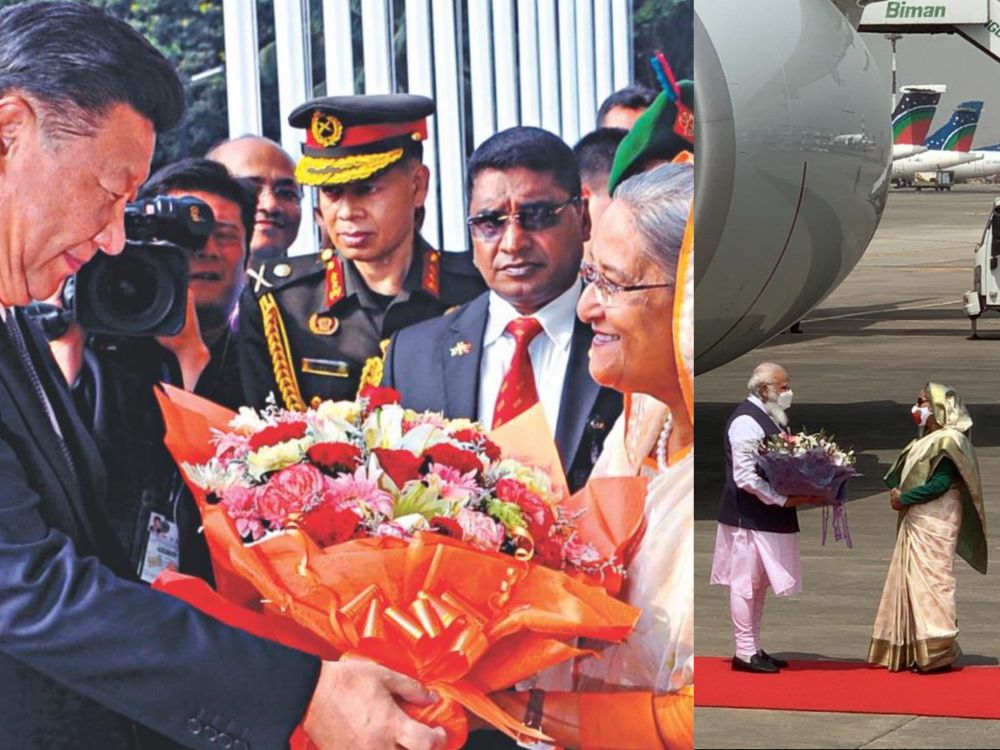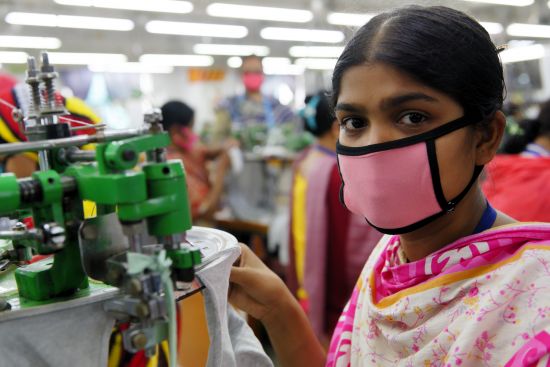The growing links between China and Bangladesh in the context of the Belt and Road Initiative has put Dhaka in the spotlight in the context of its relations with neighbor India and the United States, two major powers in conflict with Beijing. Poised to ascend to middle-income status thanks to pragmatic economic governance in recent years, Bangladesh desperately needs infrastructure development to drive growth. But, Nurul Huda Sakib and Md Ashikul Habib of Jahangirnagar University argue, as the government considers Beijing’s overtures, it should take steps to ensure that the benefits of participating in China’s signature foreign-policy initiative are maximized without the country getting caught in the middle of geopolitical storms or ending up in the thrall of the Chinese.
Welcome flowers for the neighbors, Xi and Indian Prime Minister Narendra Modi: Bangladesh PM Sheikh Hasina's government sees opportunities in China's Belt and Road Initiative but may come under pressure from New Delhi to join the Quad (Credit: left - BSS, right - @PMOIndia on Twitter)
The Belt and Road Initiative (BRI) is the path through which a more assertive China becomes a major power through economic expansion and greater geopolitical control. Although BRI is a global project with many dimensions, South Asia holds the key to its success. China is investing billions of dollars in various infrastructure megaprojects in Bangladesh and other member nations of the South Asian Association for Regional Cooperation (SAARC) such as Pakistan, Nepal, Sri Lanka and Bhutan, with which it maintains cordial relations.
At the same time, the current hostile relationship between China and India widens opportunities for other countries in South Asia. This context raises three broad issues about the relationship between Beijing and Dhaka: What are the opportunities for Bangladesh, whether or not the country could step into a debt trap if it goes all in on the BRI, and finally, what policy issues need to be addressed to develop ties. In short, Bangladesh must do what every country in the world has to do: come to terms with global China.
What are the possibilities?
Although diplomatic relations between China and Bangladesh were established in 1976 ties were insignificant until Bangladesh formally joined the BRI in 2016 through a “strategic partnership of cooperation” launched when Chinese leader Xi Jinping visited. It opened a window of opportunities for Bangladesh as China started investing far more than previously.
There is now significant Chinese influence in the Bangladesh economy. In 2018 the Dhaka Stock Exchange signed an agreement to sell a 25 percent stake to a Chinese consortium that includes the Shenzhen and Shanghai bourses. While China has been Bangladesh’s largest trading partner since 2006, relations warmed significantly after Xi’s visit. China is playing a major role in the infrastructure development of Bangladesh through involvement in BRI projects such as the such as Padma Bridge over the Ganges that links the southwest of the country to its northern and eastern regions. Other initiatives include various rail and power projects, as well as the Dhaka-Ashulia and Sitakunda-Cox's Bazar expressways.
Although there is a significant trade imbalance between the two countries (Bangladesh imports goods worth almost US$13.6 billion, while its exports total just US$560 million), China has recently waived tariffs on 97 percent of Bangladesh’s goods. To confirm its landmark graduation from least-developed-country status to middle-income economy, expected this year, Bangladesh needs to develop even more infrastructure costing over US$75 billion. BRI could help fulfil that dream as Bangladesh would stand to receive US$40 billion for BRI and joint-venture projects on top of the US$24 billion that China pledged to Bangladesh in 2016.
The debate over risks and opportunities
The growing BRI links between China and Bangladesh has attracted criticism, particularly in the context of the debate over whether China engages in “debt trap diplomacy”. Many experts argue that BRI projects and related aid are a form of economic colonialism. In 2018, then-prime minister of Malaysia, Mahathir Mohamad, cancelled several China-funded projects because of the cost. The Washington-based Center for Global Development identified six Asian countries (Pakistan, Tajikistan, the Maldives, Laos, Mongolia and Kyrgyzstan) as BRI partners with at least some risk of debt distress.
The example most often cited by critics of the BRI is the port of Hambantota in Sri Lanka, which was built with a Chinese loan that Colombo is reported to have failed to repay on time, leading to China taking a 99-year lease on the facility. Gwadar port in Pakistan is said to be a similar case. But researchers such as Deborah Bräutigam of Johns Hopkins University and Meg Rithmire of Harvard Business School have debunked the “debt trap” claims, arguing that there is a measure of transparency in Chinese financing deals and that the Chinese companies have been willing to restructure loans.
With huge infrastructure development plans in prospect, corruption could also become a serious problem as it has with BRI projects in other Asian countries such as Malaysia and Kyrgyzstan. Beijing has acknowledged the problem: According to the Supreme People’s Procuratorate (SPP) of China, corruption occurs in the processes of decision making, examination and approval, land acquisition, and material procurement. With its lack of transparency (ranked 146 out of 180 in Transparency International’s 2020 Corruption Perception Index), Bangladesh could well see graft worsen with the rolling out of BRI projects.
As Bangladesh proceeds down the BRI path, the challenges are likely to come from regional and global geopolitics as China’s tensions with both the United States and India. Bangladesh has a close relationship with the US and is geographically sandwiched between India and China. In 2020, border tension in India’s Ladakh region resulted in the deaths of both Chinese and Indian soldiers, while in 2016 another skirmish took place on the India-China-Bhutan frontiers at Doklam. China had hoped Bangladesh would serve as a bridge for its proposed Bangladesh-China-India-Myanmar economic corridor, which faltered after New Delhi pulled out.
China has also antagonized India with its “string of pearls” strategy of coastal naval installations that could encircle the South Asian country and cover the Indian Ocean. In this respect, the rivalry between Beijing and Washington has become a concern. The US has moved to revive the Quadrilateral Security Dialogue, or Quad, that brings India, Australia, Japan and the US together, with plans to counter the growing influence of China in the Indo-Pacific region in areas such as infrastructure development, supply chains, and Covid-19 vaccine supply.
Policy options for Dhaka
Bangladesh desperately needs infrastructure development. But the government should take good-governance steps to ensure it maximizes the benefits of BRI. An independent committee should be formed to operate the projects with the guidance of scholars and policymakers under the Cabinet Division. The role of this panel would be to ensure the transparency and accountability of all the decisions. Watchdogs such as the Anti-Corruption Commission, the Comptroller and Auditor General of Bangladesh and the National Board Of Revenue will have to play a major role to guard against corruption. Experts have also advised that Bangladesh marshal its domestic capital resources through tax reforms and public-private partnerships. The potential social and environmental benefits of each project need to be evaluated.
Furthermore, Chinese foreign direct investment in Bangladesh should be less oriented to natural resources and channeled more towards the manufacturing and agricultural sectors. That might reduce the threat of Bangladesh falling into the “middle-income trap” in which a country loses its competitive edge in the export of manufactured goods because of rising wages. Bangladesh should be more focused on these strengthening these basic sectors so that it can maintain robust GDP growth. This strategy might help Bangladesh become a developed nation by 2041 when it celebrates 70 years of independence.
Finally, Bangladesh should remember that the BRI alone cannot be a panacea for its economic problems. The economy should not become too reliant on any one country or project for its development. There are many other organizations such as the Asian Development Bank (ADB), the Japan International Cooperation Agency (JICA) and the International Monetary Fund (IMF) to which Dhaka can turn. One thing the government in Dhaka should understand about the BRI is the need for equipoise: It is not choosing to be pro-China or anti-China but about what is best for Bangladesh.
Further reading:
Check out here for more research and analysis from Asian perspectives.


